Ni1−xMxSe2 (M = Fe, Co, Cu) nanowires as anodes for ammonia-borane electrooxidation and the derived Ni1−xMxSe2−y–OOH ultrathin nanosheets as efficient electrocatalysts for oxygen evolution†
Abstract
Exploitation of advanced cost-effective electrocatalysts (ECs) is highly desirable for devices engaged in the production of clean energies, such as fuel cells and water electrolyzers. Herein, a series of nickel-based bimetallic selenide, Ni1−xMxSe2 (M = Fe, Co, Cu), nanowires (NWs) grown on carbon fiber paper (CFP) were first synthesized by a general approach, selenizing the corresponding bimetallic oxide NW precursor on CFP, and utilized as anodes for the ammonia-borane (AB) electrooxidation reaction (AOR) in 0.1 M KOH. These nominal Ni1−xMxSe2 anodes exhibit dramatically M-dependent catalytic activities towards the AOR and the electrocatalytic activity follows the order Ni1−xCuxSe2 > Ni1−xFexSe2 > Ni1−xCoxSe2. In particular, the catalytic activity of the Ni1−xCuxSe2 is exceptionally high, surpassing most of the previously reported ECs for the AOR. The follow-up investigations unveil that the Ni1−xMxSe2 NWs on CFP have been converted into ultrathin, porous Ni1−xMxSe2−y–OOH nanosheets (NSs) after the AOR, which presents a unique electrochemical strategy for the synthesis of novel ultrathin bimetallic selenide–oxyhydroxide NSs. Moreover, it is demonstrated that the Ni1−xMxSe2−y–OOH NS anodes exhibit much higher catalytic activities toward the oxygen evolution reaction (OER) than the pristine Ni1−xMxSe2 NW anodes because of the advanced architectures rendering larger electrochemical accessible surface areas (ECSAs) and a modified electronic structure. This work provides a new perspective for design and exploration of highly efficient and durable nonprecious-metal-based ECs for clean energy conversion devices.



 Please wait while we load your content...
Please wait while we load your content...